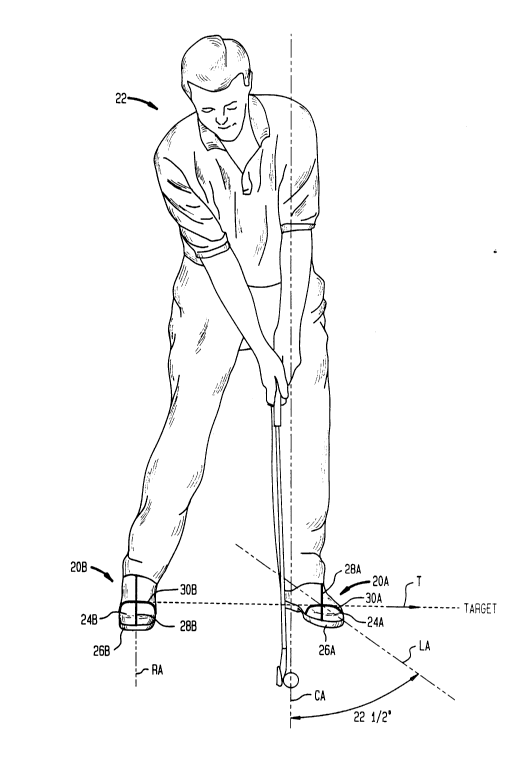Some of the information on this Web page has been provided by external sources. The Government of Canada is not responsible for the accuracy, reliability or currency of the information supplied by external sources. Users wishing to rely upon this information should consult directly with the source of the information. Content provided by external sources is not subject to official languages, privacy and accessibility requirements.
Any discrepancies in the text and image of the Claims and Abstract are due to differing posting times. Text of the Claims and Abstract are posted:
| (12) Patent: | (11) CA 2137294 |
|---|---|
| (54) English Title: | AIM IMPROVING SELF-ALIGNING GOLF SHOES |
| (54) French Title: | CHAUSSURES DE GOLF A SYSTEME DE VISEE |
| Status: | Expired |
| (51) International Patent Classification (IPC): |
|
|---|---|
| (72) Inventors : |
|
| (73) Owners : |
|
| (71) Applicants : | |
| (74) Agent: | MOFFAT & CO. |
| (74) Associate agent: | |
| (45) Issued: | 1997-07-22 |
| (22) Filed Date: | 1994-12-05 |
| (41) Open to Public Inspection: | 1995-06-16 |
| Examination requested: | 1994-12-05 |
| Availability of licence: | N/A |
| (25) Language of filing: | English |
| Patent Cooperation Treaty (PCT): | No |
|---|
| (30) Application Priority Data: | ||||||
|---|---|---|---|---|---|---|
|
A pair of golf shoes for aiding a golfer in
establishing an optimal stance and improving the
golfer's aim during driving and iron shots is disclosed.
The golf shoes comprise an upper portion and a sole
portion. The upper portion includes visual alignment
guide lines thereon for aiding a golfer in establishing
relative positioning of the golfer's feet with respect
to each other, the golf ball and the target.
Paire de souliers de golf permettant au golfeur d'avoir un écartement des pieds optimal et d'améliorer sa capacité d'alignement pendant les coups de bois et les coups de fer. Les souliers comprennent une partie supérieure et une semelle. La partie supérieure comporte des lignes d'alignement visuel pour aider le golfeur à placer ses pieds l'un par rapport à l'autre, la balle de golf et la cible dans une position relative.
Note: Claims are shown in the official language in which they were submitted.
Note: Descriptions are shown in the official language in which they were submitted.

For a clearer understanding of the status of the application/patent presented on this page, the site Disclaimer , as well as the definitions for Patent , Administrative Status , Maintenance Fee and Payment History should be consulted.
| Title | Date |
|---|---|
| Forecasted Issue Date | 1997-07-22 |
| (22) Filed | 1994-12-05 |
| Examination Requested | 1994-12-05 |
| (41) Open to Public Inspection | 1995-06-16 |
| (45) Issued | 1997-07-22 |
| Expired | 2014-12-05 |
There is no abandonment history.
| Fee Type | Anniversary Year | Due Date | Amount Paid | Paid Date |
|---|---|---|---|---|
| Application Fee | $0.00 | 1994-12-05 | ||
| Maintenance Fee - Application - New Act | 2 | 1996-12-05 | $50.00 | 1996-10-16 |
| Maintenance Fee - Patent - New Act | 3 | 1997-12-05 | $50.00 | 1997-11-17 |
| Maintenance Fee - Patent - New Act | 4 | 1998-12-07 | $50.00 | 1998-11-24 |
| Maintenance Fee - Patent - New Act | 5 | 1999-12-06 | $75.00 | 1999-11-24 |
| Maintenance Fee - Patent - New Act | 6 | 2000-12-05 | $150.00 | 2000-11-03 |
| Maintenance Fee - Patent - New Act | 7 | 2001-12-05 | $150.00 | 2001-10-24 |
| Maintenance Fee - Patent - New Act | 8 | 2002-12-05 | $150.00 | 2002-11-04 |
| Maintenance Fee - Patent - New Act | 9 | 2003-12-05 | $150.00 | 2003-11-05 |
| Maintenance Fee - Patent - New Act | 10 | 2004-12-06 | $250.00 | 2004-11-04 |
| Maintenance Fee - Patent - New Act | 11 | 2005-12-05 | $250.00 | 2005-11-04 |
| Maintenance Fee - Patent - New Act | 12 | 2006-12-05 | $250.00 | 2006-11-07 |
| Maintenance Fee - Patent - New Act | 13 | 2007-12-05 | $250.00 | 2007-11-07 |
| Maintenance Fee - Patent - New Act | 14 | 2008-12-05 | $250.00 | 2008-11-12 |
| Maintenance Fee - Patent - New Act | 15 | 2009-12-07 | $450.00 | 2009-11-10 |
| Maintenance Fee - Patent - New Act | 16 | 2010-12-06 | $450.00 | 2010-11-17 |
| Maintenance Fee - Patent - New Act | 17 | 2011-12-05 | $450.00 | 2011-11-17 |
| Maintenance Fee - Patent - New Act | 18 | 2012-12-05 | $450.00 | 2012-11-15 |
| Maintenance Fee - Patent - New Act | 19 | 2013-12-05 | $450.00 | 2013-11-14 |
Note: Records showing the ownership history in alphabetical order.
| Current Owners on Record |
|---|
| GOLDSTEIN, MARC |
| Past Owners on Record |
|---|
| None |